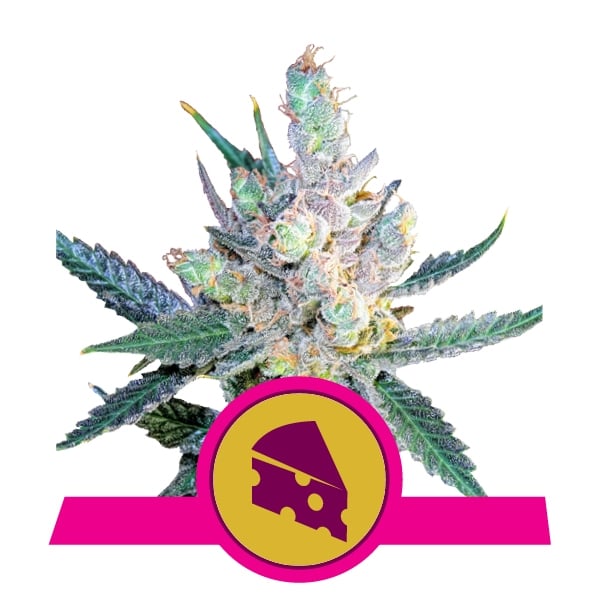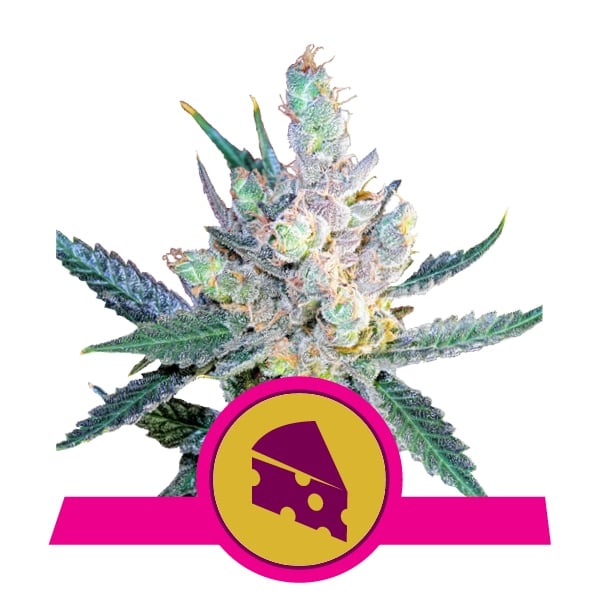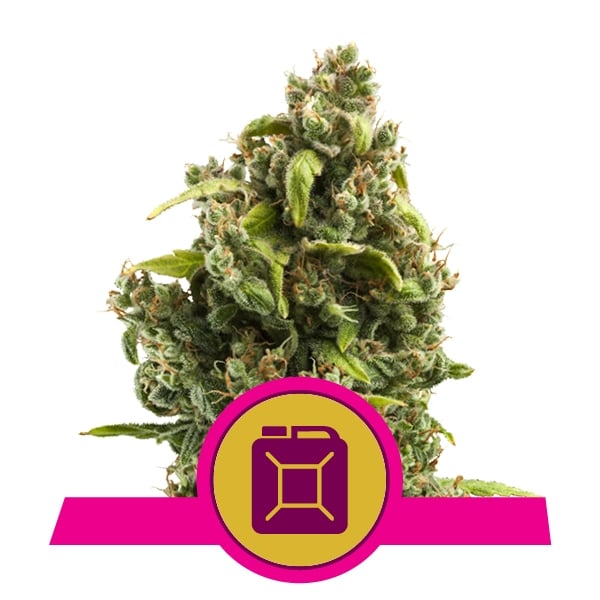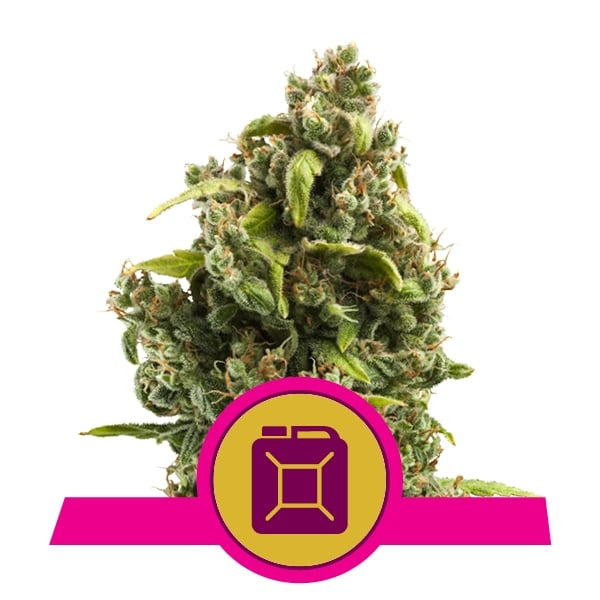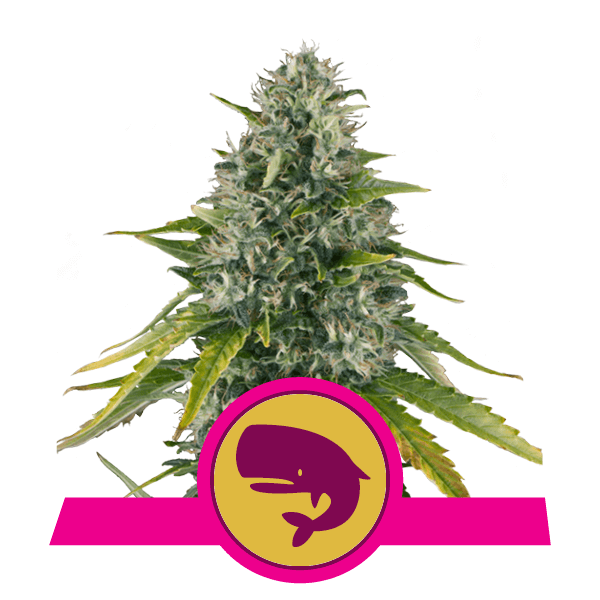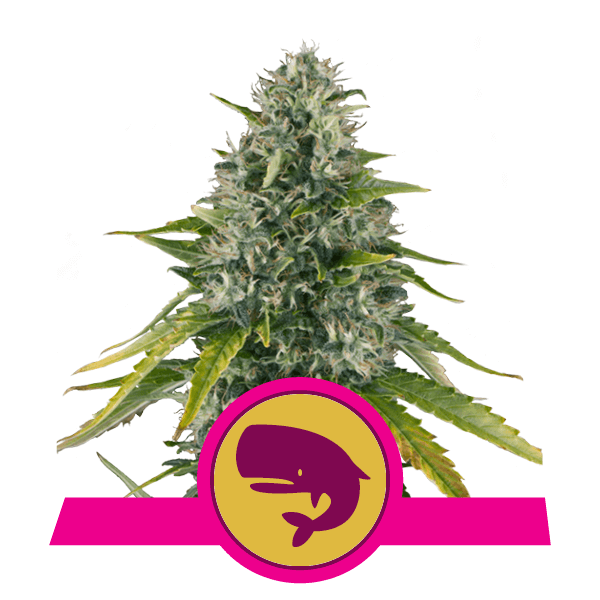.
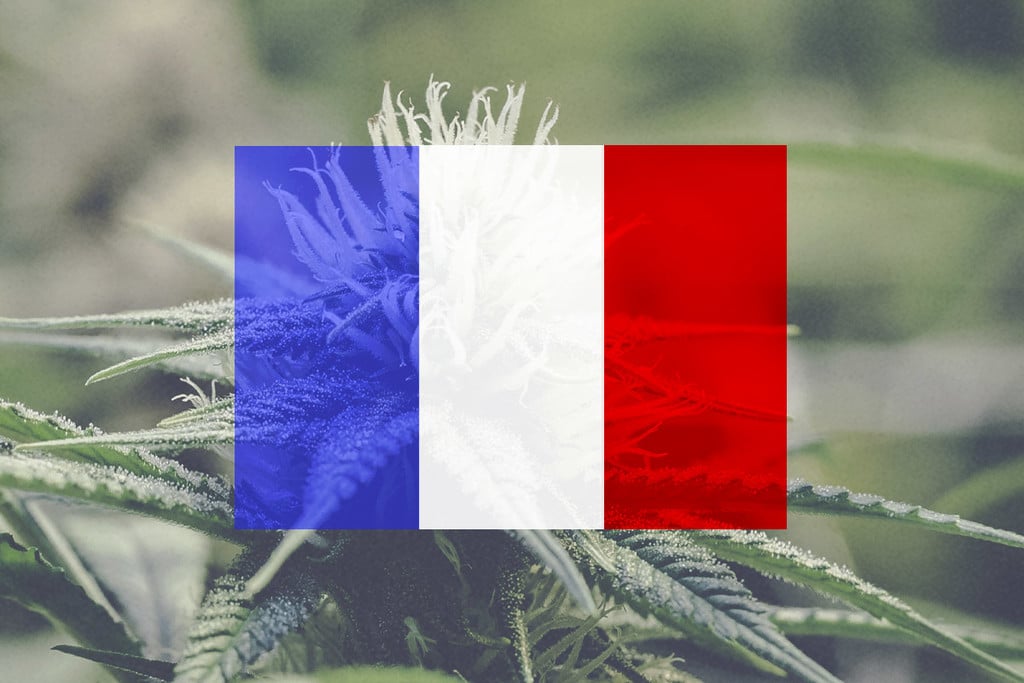
Growing Cannabis Outdoors In France: A Month-By-Month Guide
France provides a great climate for growing weed: lots of rain, plenty of sunshine, and a long growing season. Use the guide below to learn how to grow weed in different regions, when to harvest, and what strain will work best for you.
Growing cannabis outdoors in France: A complete month-by-month guide.
Contents:
As a truly beautiful country, France features multiple climates with diverse terrain and landscapes. Although wine grapes and corn make up the bulk of crops in the country, cannabis growers also rake in fantastic harvests year after year.
Cultivators in every country face unique climatic and legal challenges. Once you become familiar with these factors, though, you’ll be ready to get your hands in the soil.
GROWING CANNABIS IN FRANCE IN 2025
France features varying climates across the country. You’ll need to become familiar with your local climate. The three distinct climates in France are:
• Oceanic: Sweeping along the west of the country from north to south, the oceanic zone features a small temperature range, cool summers, and very cold winters. Paris, Toulouse, and Bordeaux autumn into this zone.
• Continental: Found in much of eastern and central France, this zone features warmer summers, ample rainfall, and snowy winters. The continental zone encompasses Lyon and Strasbourg.
• Mediterranean: widespread in the South of France (except for the oceanic southwest), this zone sees hot summers, limited rainfall, and cool winters.
Each climate comes with unique demands when it comes to raising cannabis, but all of them offer the potential for huge yields of dank flowers!
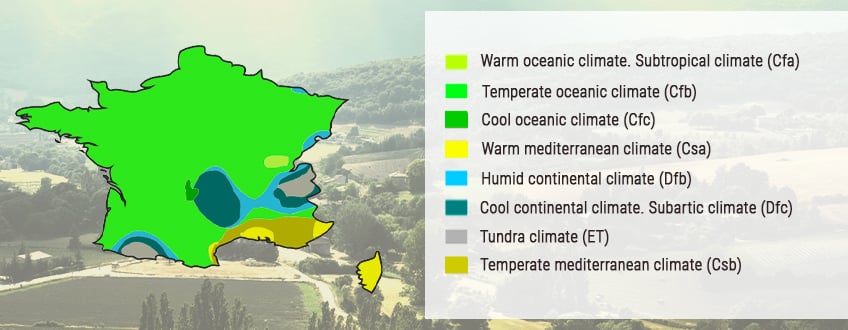
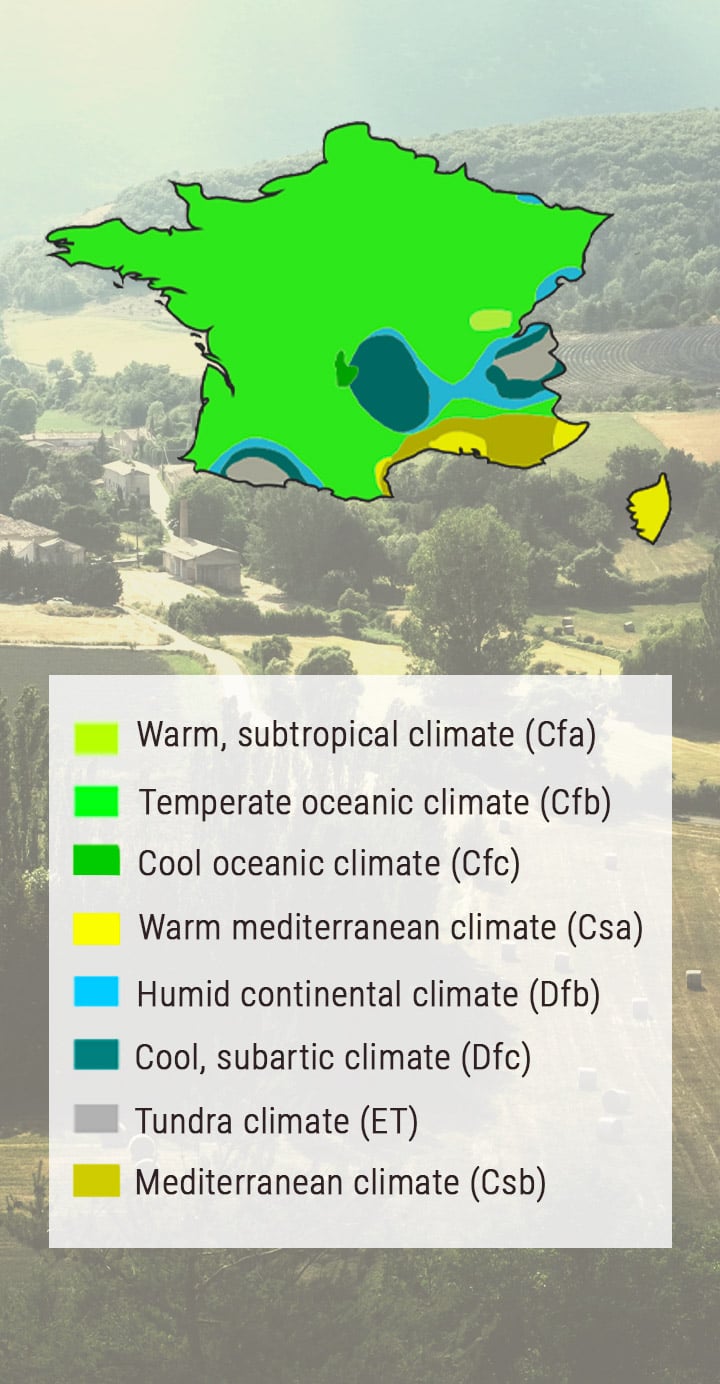
IS WEED LEGAL IN FRANCE?
Much like many other European countries, the population of France has a soft spot for cannabis. Statistics from the nation reveal that approximately 13 million citizens have experienced the mind-altering effects of THC, and 1.2 million use the herb regularly.
With that said, France has some of the least progressive cannabis laws on the continent. Cultivation, sale, possession, and use of cannabis are all illegal. Until recently, the harsh consequences of using cannabis involved fines of up to €3,750 and a one-year prison sentence. However, recent changes to legislation have softened the blow to fines of up to €200.
Growing cannabis in France is a different story and comes with extremely harsh punishments. Depending on the scale, fines can reach sums of €7.5 million and jail sentences up to 20 years. Although very few cultivators have received the maximum punishments, even those growing for personal use face legal consequences.
However, France does appear to be slowly opening itself up to cannabis. CBD products with THC levels below 0.2% are legal, and, in 2014, the country finally allowed the use of cannabis-based product Sativex, which features a 1:1 ratio of THC to CBD.
Although things are moving much slower than other countries, groups are still fighting to legalize the herb. Organisations such as NORML France are working to inform and educate citizens, support cannabis users’ rights, and promote scientific research.
Overall, growing cannabis in France exposes cultivators to legal repercussions, although many green-fingered guerrillas enjoy harvests every year without falling into trouble.
A GUIDE ON GROWING CANNABIS OUTDOORS IN FRANCE
France features a complex array of climates and terrains, from the windy and cool coast to rocky, high-altitude mountains. To keep things simple, we’re going to focus on locations in the north (Paris), east (Lyon), west (Nantes), and south (Marseille). These areas cover all of the major climate considerations when growing cannabis.
Of course, it will help if you conduct some deeper research into your local microclimate to really dial things in for your grow. However, the information provided below will form the foundation of your outdoor growing strategy.
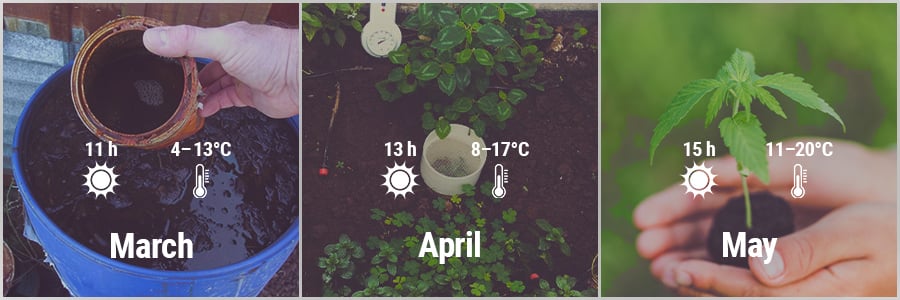
MARCH
• Day length March 1st: 11h 2m
• AVG temperature: 4–13°C
The first signs of spring begin to appear in March. However, this month involves doing most of the work indoors. Begin germinating seeds to get a head start on the season. As soon as the weather gets warm enough, you’ll have some mature seedlings ready to meet the soil.
While you’re waiting for your seeds to put out tails, head into the garden to prepare your growing space—hoe and mulch your beds to take out any early weeds and prevent new ones. Start topdressing your containers with compost that will eventually provide a source of nutrients for your plants.
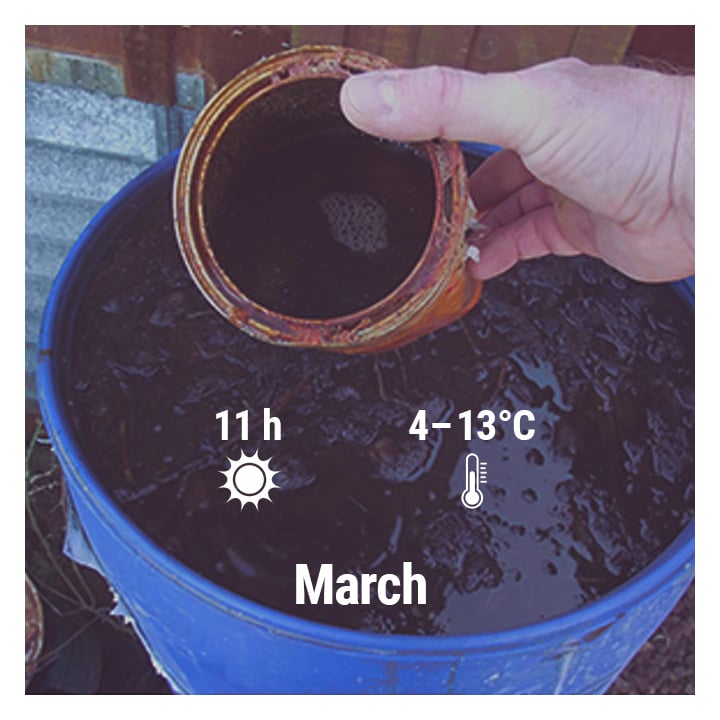
APRIL
• Day length April 1st: 12h 56m
• AVG temperature: 8–17°C
Spring enters full swing in April. Longer daylight hours means things are starting to warm up. However, the risk of frost remains significant for most of the country. Keep your plants indoors under LED lights or in the protective warmth of a greenhouse.
The Mediterranean south, including Marseille, offers an exception. The last frost usually occurs in late February in this region. Seedlings can be transplanted into containers and left outside. You always have the option to move them into a greenhouse or polytunnel if the forecast predicts a cold snap.
Aim to keep weeds under control in your garden beds. Heavy mulching will hold most of them at bay, but you can remove any others by hand. You can also start sowing hardy companion plants like peppermint into beds and containers. These will help keep pest insects away from your cannabis plants later down the line, while also obscuring the sight and smell of your plants.
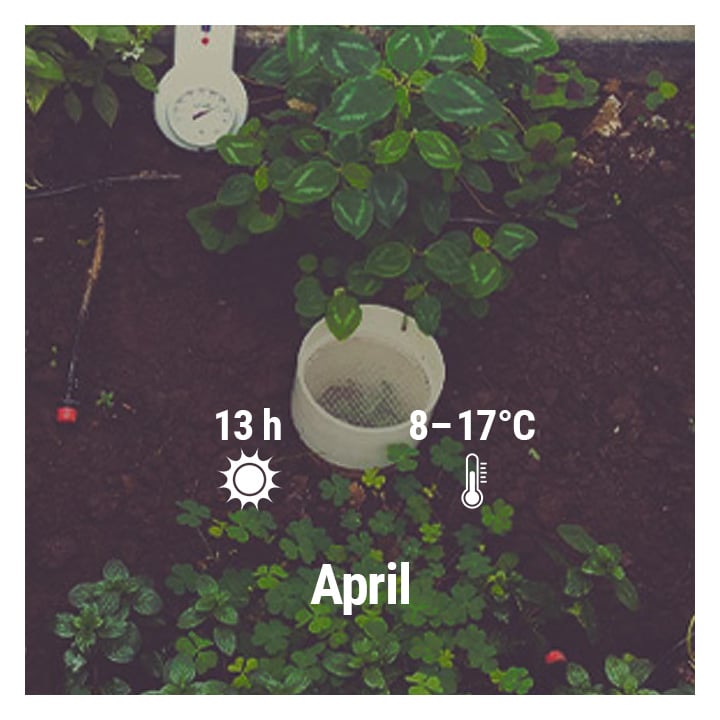
MAY
• Day length May 1st: 14h 47m
• AVG temperature: 11–20°C
The heat of late spring means the last frost date has passed in the vast majority of growing regions. By mid-May, you can safely move your seedlings into containers or garden beds outdoors. Introduce your seedlings to a medium of living soil mixed with compost and manure. This concoction of nutrients and microbes will supply plants with baseline nutrition for the entire season.
Growers in central France should still be cautious of a final cold spell. Transplant into containers first and move them into the greenhouse if you suspect more frost.
If you’re growing in greenhouses or polytunnels in the warmer south, heat can become the enemy. Make sure your structures are well-ventilated (maybe even install greenhouse fans) to prevent plants from wilting.
The east and west of France receive a good amount of annual rainfall. Your plants should be well hydrated in these regions. Water early and late in the day to prevent evaporation and make the most of your resources.
If not, water the soil every time the top inch or so becomes totally dry. If you’re experiencing excess rainfall, consider erecting a temporary structure such as a tarp to protect your plants against overwatering.
You’ll also need to start feeding your plants around every ten days. Organic seaweed fertiliser—applied as a root drench or foliar spray—will provide your plants with most of the nutrients they need. Mix with water in the ratio suggested by the specific product.
Weeds will be making a charge at this point. Keep them under control by picking them out of the soil and adding more mulch if necessary.
With the weather picking up, you can start to sow different companion plants such as chamomile and lavender. They’ll help to distract pest species and bring in beneficial insects. If you live in a rural area, consider erecting fencing and netting around your beds to keep wandering deer and boar from rummaging through your crop.
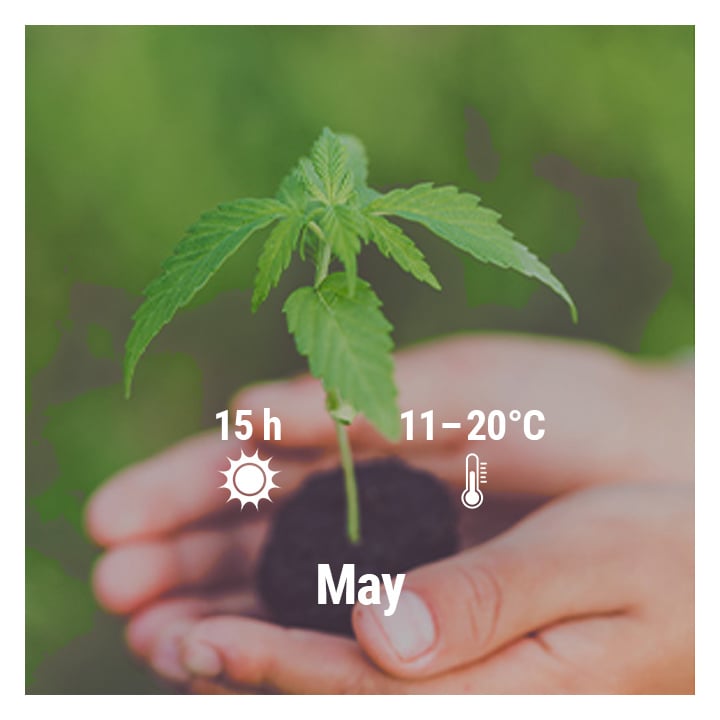
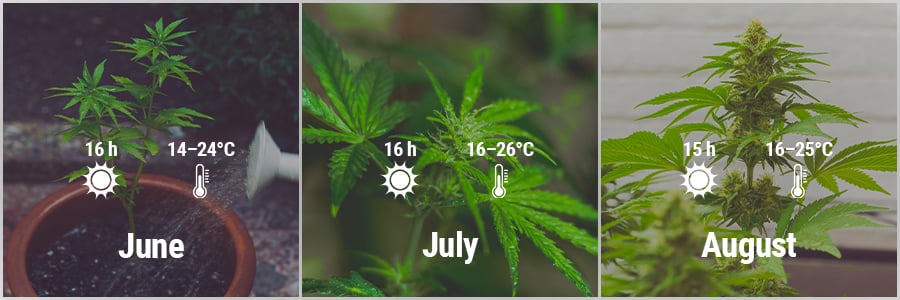
JUNE
• Day length June 1st: 15h 55m
• AVG temperature: 14–24°C
June sees temperatures continuing to rise, with the summer solstice taking place on the 20th of the month. Increasingly, intense heat and less rainfall mean you’ll need to monitor your soil frequently. Add more mulch as the layer from earlier on in the season begins to break down. Anything from straw to wood chips will help trap in moisture.
Be sure to stay on top of watering, and consider setting up a drip irrigation system if you’re overseeing numerous plants. This will save you a lot of time and water in the long-run.
Plants in the Mediterranean south and north of the country will likely require watering once per day in the evenings. You’ll probably need to water less frequently in the east and west thanks to more frequent precipitation.
Keep your plants well-fed following the instructions on your chosen fertiliser, and continue to dress your topsoil with compost and worm castings for slow-release nutrients that will become available later in the season.
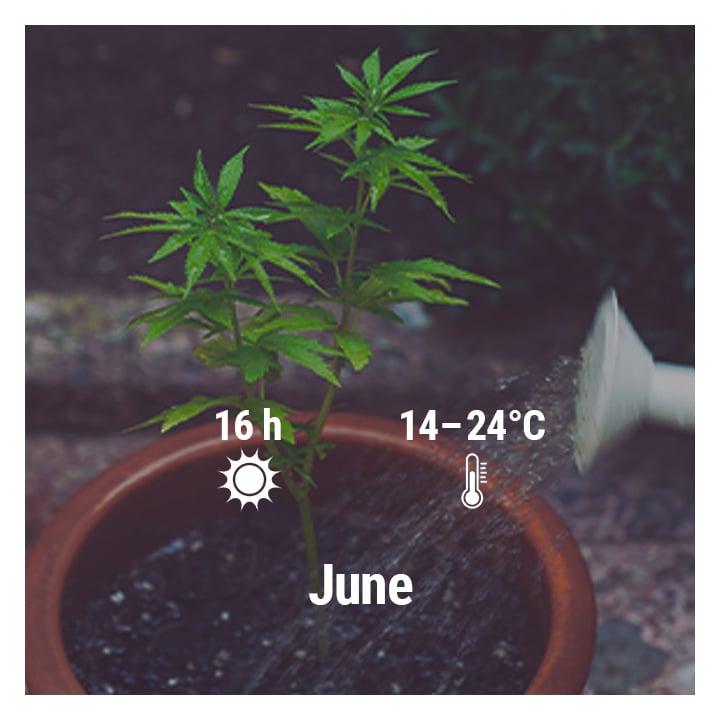
At this stage, your plants will be ready to tolerate training techniques. Employ methods such as topping and low-stress training to open up space in the canopy, reduce mould risk, build a discrete structure of the plant and boost yields.
Areas around Marseille and Paris can get notoriously windy from time to time. If your tall sativa strains are taking a beating from heavy gusts, use stakes to provide additional support.
JULY
• Day length July 1st: 16h 6m
• AVG temperature: 16–26°C
Things are heating up during France’s hottest month! Grab an icy glass of cannabis lemonade and head out into the garden to see what needs taking care of.
You’ll notice your soil becoming drier, quicker. Stay on top of watering every day in the mornings and evenings. Run routine checks on your irrigation system to troubleshoot any leaks or blockages.
If you’re carrying out low-stress training, continue to train new offshoots and bring them to the same height as the rest of the canopy.
An increase in daylight hours will lead to heavy and explosive vegetative growth. Routinely check the health of the larger fan leaves on your plants. If all goes well, they should display straight, dark green fingers. If you notice any discolouration or curling at the tips, consult this deficiency guide.
Patrol your garden once every few days to keep an eye out for pests. Your companion plants will do a good job preventing undesirable insects, but sometimes they can get overwhelmed. If so, try introducing beneficial insects such as ladybugs, or spraying your plants with neem oil.
If you started with regular seeds as opposed to feminised, your plants will begin to reveal their sex during July. Look closely at the nodes—the points where branches join the main stem—to search for pre-flowers. Female pre-flowers present as small teardrops with protruding hairs, while male pre-flowers emerge as smooth sacs with no hair. Remove the males from your garden immediately to prevent them from pollinating the females.
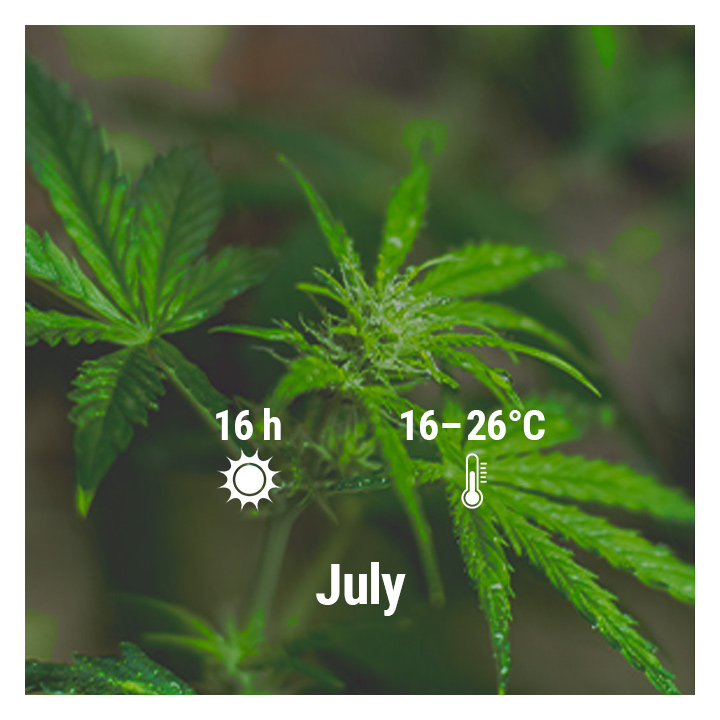
AUGUST
• Day length August 1st: 15h 4m
• AVG temperature: 16–25°C
Summer continues to provide warm weather and plenty of sunshine. However, August sees a slight decline in daylight. Cannabis plants pick up on this signal as a sign of the approaching autumn, which triggers them to begin flowering. Stop all training going forwards.
Flowering cannabis plants have a slightly different demand for nutrients. Switch out your fertiliser for something slightly lower in nitrogen and higher in potassium and phosphorus. Add a top dressing of worm castings, kelp meal, and bone meal to provide your plants with the nutrients they need to develop large, resinous flowers.
Your plants will begin to stretch during the early flowering phase. Use a trimmer to defoliate the larger leaves to allow more light to enter the canopy and swell up each bud site. This practice will also help to fend off mould. The whole of France sees an average annual humidity of 70–80%. Routinely check developing bud sites for signs of mould. Keep your greenhouse fans running and be particularly vigilant after heavy and extended periods of rain and fog. Learn how to identify, prevent, and treat mould problems here.
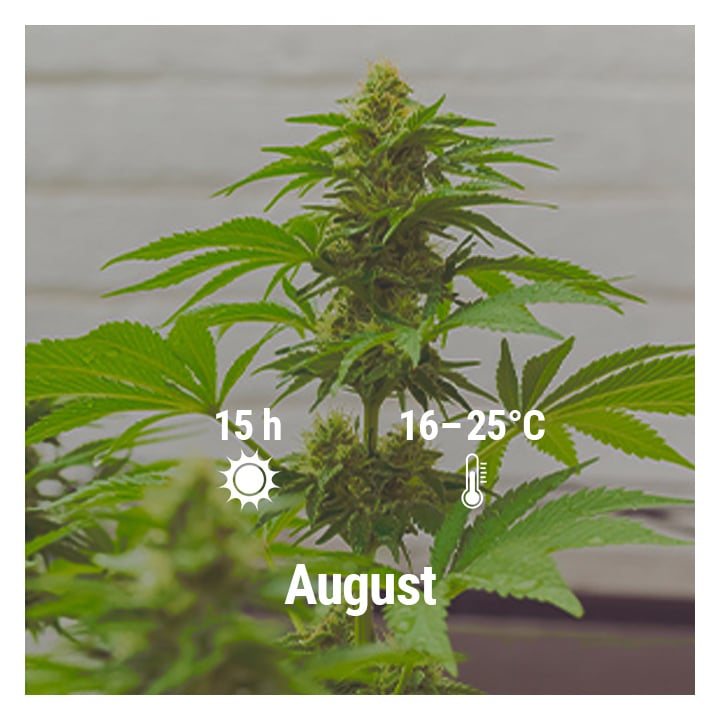
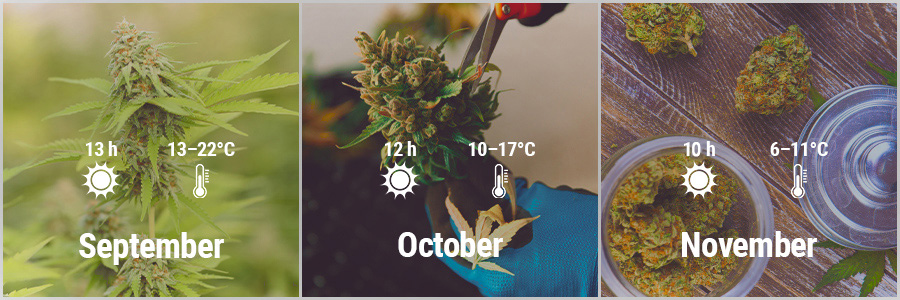
SEPTEMBER
• Day length September 1st: 13h 24m
• AVG temperature: 13–22°C
The days continue to become shorter, the temperature drops further, and autumn begins to set in. As one of the most exciting months of the entire grow, you’ll notice your flowers beginning to put on weight during September.
As your flowers develop more trichomes, they’ll produce an abundance of resin. Your neighbours might start to catch on to your operation at this point. Luckily, the companion plants you sowed earlier in the year—such as lavender—will also be putting out heavy aromas that help to mask the signature smell of cannabis.
Southwestern France—Bordeaux and Biarritz in particular—sees some of the heaviest rainfall. If your plants are in containers, move them into a polytunnel or greenhouse away from excess moisture to protect them from mould.
Continue feeding your plants with a blooming formula and keep on top of weeding. Birds usually become more active during this time—place netting around your plants to protect your leaves and flowers from their hungry beaks.
The first frost can occur in the mountains during early September. Harvest your autos before this time, and move photoperiod strains into the greenhouse.
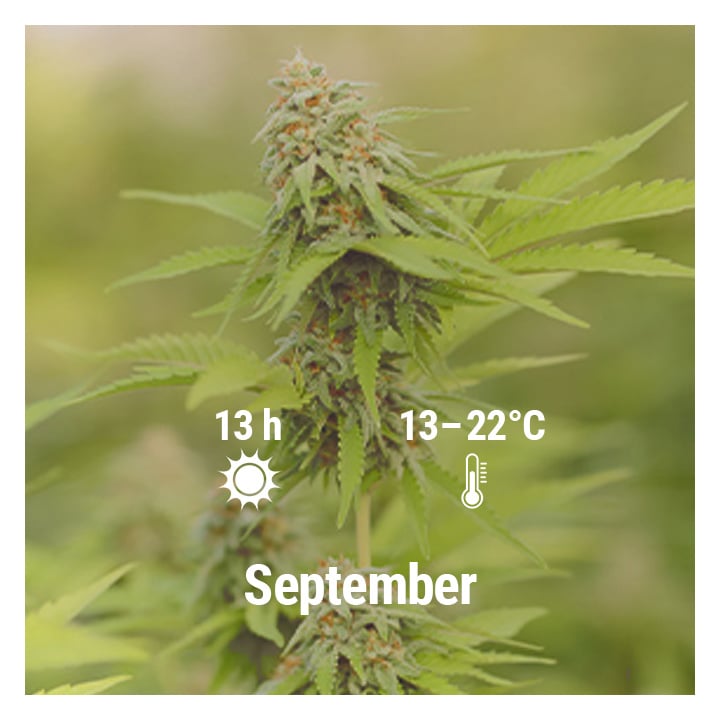
OCTOBER
• Day length October 1st: 11h 38m
• AVG temperature: 10–17°C
Autumn enters full swing in October. Rainfall remains steady around Paris but surges around Marseille and Lyon. Get your plants out of the rain and into the greenhouse if possible. Central and eastern France typically experience first frost during the end of October, so you’ll need to move plants into the greenhouse if you live in these areas, too.
Faster-flowering indica cultivars will be ready to harvest in early October. Begin restricting nutrient feeding two weeks before harvest to flush your plants for a smooth and flavourful taste. You can also start to harvest companion plants such as lavender to make soothing teas.
Continue feeding and defoliating longer-flowering sativa strains to optimise yields and win the battle against mould.
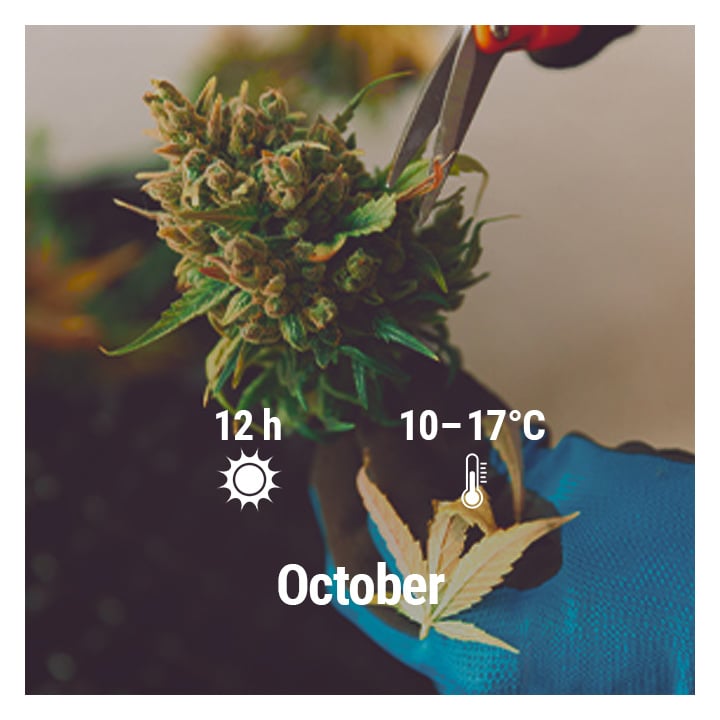
NOVEMBER
• Day length November 1st: 9h 52m
• AVG temperature: 6–11°C
The leaves are starting to really drop from the trees, and the temperatures start to dip significantly. Lyon, Paris, and Marseille will see their first frost during this month. If things get extremely cold, bring some heaters into your greenhouse and wrap containers in bubble wrap to insulate your plants.
Hold back on feeding your sativa strains two weeks before harvest. Keep a close eye on the forecast if your plants are still in beds, and be sure to harvest before the first frost sets in. Now it’s time to dry and cure your bounty!
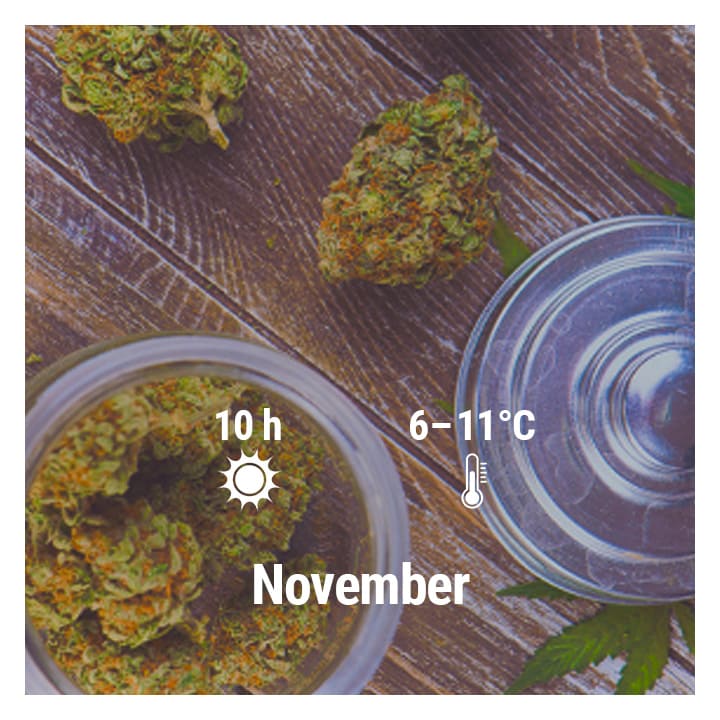
PROS AND CONS OF GROWING CANNABIS OUTDOORS IN FRANCE
Growing cannabis in France comes with a set of advantages and disadvantages. Here are the upsides and downsides of raising a crop in the country:
Pros:
• Balanced climate
• Plenty of rainfall
• Lengthy growing season
• Plenty of sunshine
Cons:
• Excessive rain in some regions
• High humidity can lead to mould issues
• Draconian laws make growing a high-risk, high-reward decision
• Intense heat in the south
• Early frost in the mountains
TOP 3 RQS STRAINS RECOMMENDED FOR OUTDOOR GROWING IN FRANCE
As a versatile and hardy plant, cannabis grows comfortably in many regions around the world. Still, certain cultivars are more suited to certain climates than others. The three strains below are perfect for growing in different areas of France.
• Royal Cheese (Fast Flowering) — For growers in mountainous regions
As a fast flowering cultivar, Royal Cheese provides a good option for growers facing an early frost in the mountains and central and eastern France. She produces gorgeous, compact flowers boasting shades of deep purple and green. Her THC content of 17% and relaxing terpenes converge to produce a comforting body high. Outdoors, she’ll reach a height of up to 200cm and produce a rewarding bounty of 550–600g/plant.
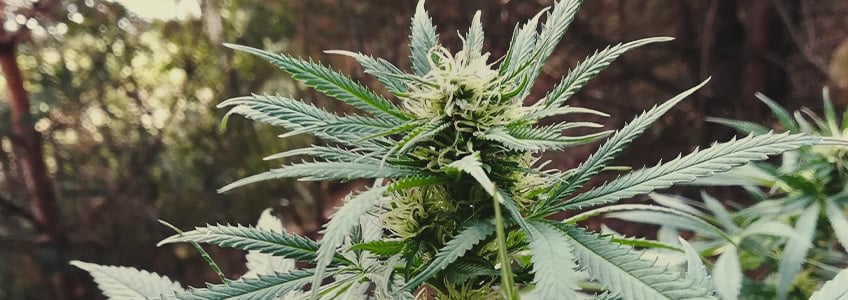
| Royal Cheese (Fast Flowering) | |
| Old School Skunk x Afghani | |
| 550 - 600 gr/m2 | |
| 60 - 100 cm | |
| 6 - 8 weeks | |
| THC: 17% (aprox.) / CBD: Medium | |
| 40% Sativa, 60% Indica, 0% Ruderalis | |
| 550 - 600 g/per plant (dried) | |
| 130 - 200 | |
| Early October | |
| A combination of stoned + high |
Royal Cheese (Fast Flowering)
| Old School Skunk x Afghani | |
| 550 - 600 gr/m2 | |
| 60 - 100 cm | |
| 6 - 8 weeks | |
| THC: 17% (aprox.) / CBD: Medium |
| 40% Sativa, 60% Indica, 0% Ruderalis | |
| 550 - 600 g/per plant (dried) | |
| 130 - 200 cm | |
| Early October | |
| A combination of stoned + high |
Buy Royal Cheese (Fast Flowering)
• Sour Diesel — For growers in the South of France
Sour Diesel features a sativa-dominant genetic profile, meaning she has a longer flowering time. Ideal for the longer growing season in the south, she’ll push harvest into November, offering around 600g/plant. Her mature flowers churn out an abundance of resin with a THC content of 19%. Enjoy her buzzing head high and energising, citrusy terpenes.
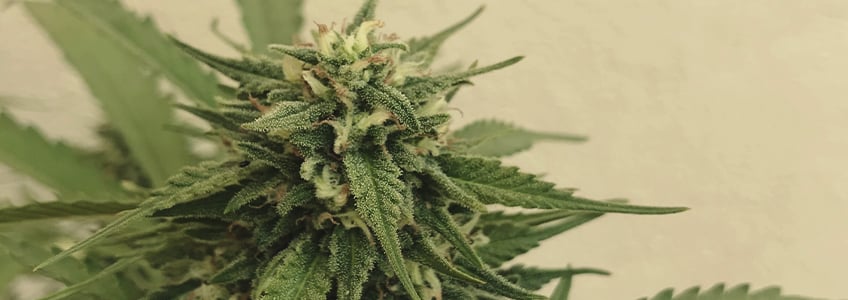
| Sour Diesel | |
| Original Diesel x (Northern light x Shiva x Hawaiian) | |
| 475 - 525 gr/m2 | |
| 90 - 160 cm | |
| 10 - 11 weeks | |
| THC: 18% (aprox.) / CBD: Low | |
| 70% Sativa, 30% Indica, 0% Ruderalis | |
| 550 - 600 gr/plant | |
| 150 - 200 | |
| Late October | |
| Physical, clear high |
Sour Diesel
| Original Diesel x (Northern light x Shiva x Hawaiian) | |
| 475 - 525 gr/m2 | |
| 90 - 160 cm | |
| 10 - 11 weeks | |
| THC: 18% (aprox.) / CBD: Low |
| 70% Sativa, 30% Indica, 0% Ruderalis | |
| 550 - 600 gr/plant | |
| 150 - 200 cm | |
| Late October | |
| Physical, clear high |
• Royal Moby — Grow her anywhere!
Royal Moby descends from legendary parent strains Haze and White Widow. Her hardy pedigree means she's resistant to pests and mould—ideal traits for the humid climate in most of France. She produces massive harvests of 700g/plant and a well-balanced high that soothes the body and stimulates the mind.
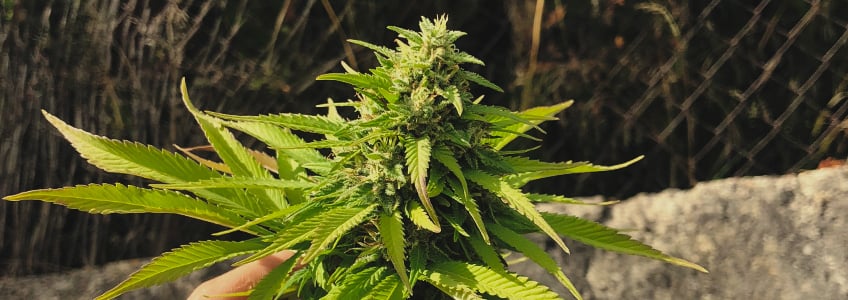
| Royal Moby | |
| Haze x White Widow | |
| 550 - 600 g/m2 | |
| 80 - 140 cm | |
| 9 - 10 weeks | |
| THC: 21% (aprox.) / CBD: Low | |
| 65% Sativa, 35% Indica | |
| 650 - 700 g/per plant (dried) | |
| 200 - 300 cm | |
| Late October | |
| A combination of stoned + high |
Royal Moby
| Haze x White Widow | |
| 500 - 550 g/m2 | |
| 80 - 140 cm | |
| 9 - 10 weeks | |
| THC: 21% (aprox.) / CBD: Low |
| 65% Sativa, 35% Indica | |
| 500 - 550 g/per plant (dried) | |
| 200 - 300 cm | |
| Late October | |
| A combination of stoned + high |
GROW CANNABIS IN FRANCE!
France provides superb climates for growing cannabis. Neither too short nor too long, the growing season provides the right length for successful indica and sativa harvests. Growers in the mountains and cooler centre and east should prepare with polytunnels and greenhouses, and cultivators all over the country should be ready to tackle mould due to humidity.
With those factors aside, growing cannabis in France offers an easy reward. A good balance of rainfall and sunshine make growing weed in the country almost effortless. Draconian laws hold many people back from enjoying their own cannabis harvest, but hopefully, the trend of tolerance and acceptance continues!


























